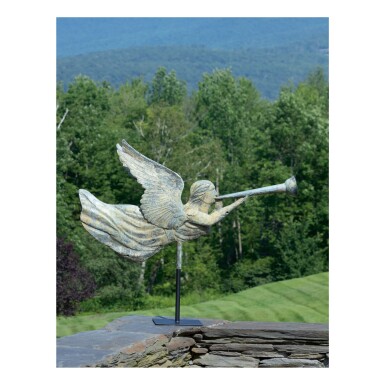
HIGHLY IMPORTANT MOLDED FULL BODIED SHEET COPPER ANGEL GABRIEL WEATHERVANE, POSSIBLY MOTT CO., CHICAGO, ILLINOIS, CIRCA 1872
Auction Closed
October 10, 05:49 PM GMT
Estimate
300,000 - 500,000 USD
Lot Details
Description
HIGHLY IMPORTANT MOLDED FULL BODIED SHEET COPPER ANGEL GABRIEL WEATHERVANE, POSSIBLY MOTT CO., CHICAGO, ILLINOIS, CIRCA 1872
verdigis surface retains traces of its original gold leaf and paint sizing.
Height 36 ½ in. by Length 65 in. by Width 8 ¾ in.
Made for the Christian Chapel in Franklin, Ohio when it was constructed in 1872;
Giampietro American Folk Art, New Haven, Connecticut.
R. Scudder Smith, "Angel Gabriel Weathervane Comes Down To Earth," Antiques and the Arts Weekly, February 8, 2011.
The Gabriel Weathervane, also known as "Fame," is considered the most desirable and rare form in the iconography of American weathervanes. This figure embodies the transcendence of Heaven upon the mortal earth.
The specifics of the sculptural figure declare its unique and original interpretation, one that transcends the category of weathervanes. The beautiful weathered surface, combined with the artist's aesthetic decisions, create a serendipity of nature and man, further extending the elegance and mystery of this masterful and unique American weathervane.
Weathervanes depicting the trumpeting Angel Gabriel, which combined Biblical references to the Annunciation and the Last Judgment, topped a number of American churches. The earliest Gabriel weathervanes were flat silhouettes, cut and wrought from sheets of iron such as lot 15. This vane’s bold three-dimensional form and patina set it apart.
As recorded in Luke 1:26, Gabriel was the angel “sent from God” to inform the Virgin Mary that she “shalt conceive in thy womb, and bring forth a son, and shalt call his name JESUS…And he shall reign over the house of Jacob for ever; and of his kingdom there shall be no end.” While trumpeting angels are mentioned in the Bible, Gabriel is not identified as one of them, and the first English mention of Gabriel blowing a trumpet is in John Milton’s Paradise Lost.
